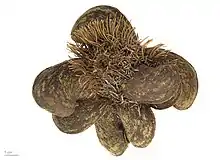Banksia candolleana
Banksia condolleana, commonly known as the propeller banksia,[2] is a species of shrub that is endemic to Western Australia. It has shiny green, deeply serrated leaves with triangular lobes and spikes of golden yellow flowers on short side branches.
| Propeller banksia | |
|---|---|
 | |
| Banksia candolleana, near Badgingarra | |
| Scientific classification | |
| Kingdom: | Plantae |
| Clade: | Tracheophytes |
| Clade: | Angiosperms |
| Clade: | Eudicots |
| Order: | Proteales |
| Family: | Proteaceae |
| Genus: | Banksia |
| Species: | B. candolleana |
| Binomial name | |
| Banksia candolleana | |
| Synonyms[1] | |
|
Sirmuellera candolleana (Meisn.) Kuntze | |


Description
Banksia candolleana is a many-branched shrub that typically grows to 0.5–1.3 m (1 ft 8 in–4 ft 3 in) high, up to 2.5 m (8 ft 2 in) wide and forms a lignotuber. Its leaves are linear in outline, 15–40 mm (0.59–1.57 in) long and 6–20 mm (0.24–0.79 in) wide on a hairy petiole 10–20 mm (0.39–0.79 in) long. The leaves are shiny green with deep triangular lobes on the margins. The flower spikes are arranged in oval spikes 15–40 mm (0.59–1.57 in) long and 55–75 mm (2.2–3.0 in) wide on short side branches. The flowers are golden yellow with a perianth 20–27 mm (0.79–1.06 in) long and a curved pistil 25–35 mm (0.98–1.38 in) long. Flowering occurs from April to July and usually up to five curved, egg-shaped follicles 20–65 mm (0.79–2.56 in) long, 25–50 mm (0.98–1.97 in) high, 17–35 mm (0.67–1.38 in) wide and surrounded by the old flowers form on each spike.[2][3][4][5]
Taxonomy
Banksia candolleana was first formally described in 1855 by the Swiss botanist Carl Meissner in William Jackson Hooker's Journal of Botany and Kew Garden Miscellany from specimens collected by James Drummond.[6][7] The specific epithet honours Meissner's countryman Augustin Pyramus de Candolle.[3]
Distribution and habitat
Propellor banksia is found from Arrowsmith south to Gingin on sandplains north of Perth where it usually grows in low kwongan and the annual rainfall is 600–700 mm (24–28 in).[3]
Ecology
Banksia candolleana regenerates from a woody lignotuber after bushfire.[3] Some large shrubs have been estimated at 1,000 years old.[8] The white-tailed dunnart ( Sminthopsis granulipes) has been recorded visiting flowerheads, though whether it is an effective pollinator is unknown.[9] Ants and bees, including the European honeybee, have been recorded visiting flower spikes.[10]
Use in horticulture
Banksia candolleana is slow growing in cultivation and may take up to 10 years to flower from seed. It grows readily in well-drained soils in Mediterranean climates,[3] but does not do well in climates of higher humidity on the east coast of Australia. Seeds do not require any treatment, and take 22 to 35 days to germinate.[11]
References
- "Banksia candolleana". Australian Plant Census. Retrieved 10 April 2020.
- "Banksia candolleana". FloraBase. Western Australian Government Department of Parks and Wildlife.
- George, Alex S. (1996). The Banksia Book (3rd ed.). Kenthurst, New South Wales: Kangaroo Press. pp. 110–12. ISBN 0-86417-818-2.
- George, Alex S. (1999). Flora of Australia (PDF). 17B. Canberra: Australian Biological Resources Study, Canberra. pp. 201–203. Retrieved 10 April 2020.
- George, Alex S. (1981). "The Genus Banksia L.f. (Proteaceae)". Nuytsia. 3 (3): 333–335. Retrieved 11 April 2020.
- "Banksia candolleana". APNI. Retrieved 10 April 2020.
- Meissner, Carl; Hooker, William Jackson (1855). "New Proteaceae of Australia". Hooker's Journal of Botany and Kew Garden Miscellany. 7: 118–119. Retrieved 11 April 2020.
- He, Tianhua; Lamont, Byron B.; Downes, Katherine S. (2011). "Banksia born to burn". New Phytologist. doi:10.1111/j.1469-8137.2011.03663.x.
- Goldingay, Ross L. (2000). "Small Dasyurid Marsupials – are they Effective Pollinators?". Australian Journal of Zoology. 48 (5): 597–606. doi:10.1071/ZO00015.
- Taylor, Anne; Hopper, Stephen (1988). The Banksia Atlas (Australian Flora and Fauna Series Number 8). Canberra: Australian Government Publishing Service. ISBN 0-644-07124-9. pp. 72–73.
- Sweedman, Luke; Merritt, David (2006). Australian seeds: a guide to their collection, identification and biology. CSIRO Publishing. p. 202. ISBN 0-643-09298-6.
| Wikisource has original text related to this article: |
| Taxon identifiers |
|
|---|